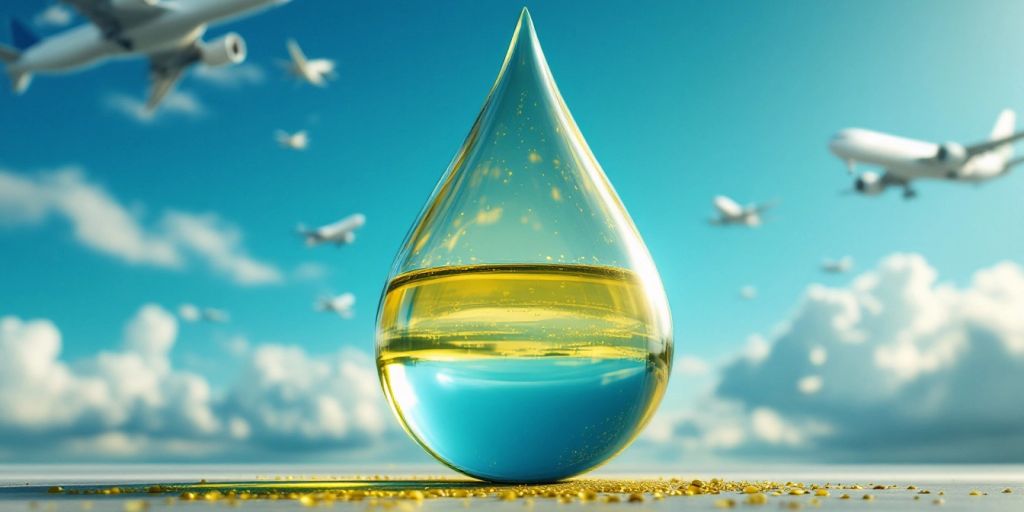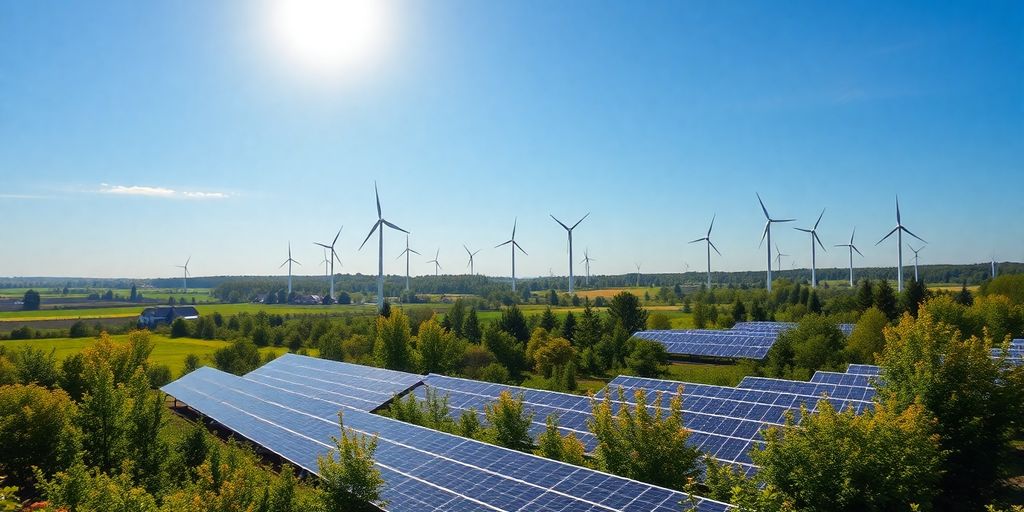What is SAF (Sustainable Aviation Fuel) and How Does It Impact the Future of Aviation?

Sustainable Aviation Fuel (SAF) is a promising solution to help the aviation industry reduce its carbon footprint. As airlines aim for net-zero carbon emissions by 2050, SAF could play a crucial role in achieving this goal. This article explores what SAF is, how it is produced, its environmental benefits, economic implications, and the challenges it faces in becoming the fuel of choice for aviation.
Key Takeaways
- SAF is a type of biofuel made from plant and animal materials, reducing reliance on fossil fuels.
- It can cut carbon emissions by up to 80% compared to traditional jet fuels.
- Current regulations allow for a maximum of 50% SAF in fuel mixtures, but 100% SAF use is expected by 2030.
- The aviation industry is committed to using SAF to meet net-zero carbon emission goals by 2050.
- Challenges like high costs and limited production capacity are barriers to wider SAF adoption.
Understanding Sustainable Aviation Fuel
Definition and Composition of SAF
Sustainable Aviation Fuel (SAF) is a type of biofuel made from renewable resources like plants and animal materials. It is designed to be a drop-in replacement for traditional jet fuel, meaning it can be used in existing aircraft engines without any modifications. SAF can reduce greenhouse gas emissions by up to 80% compared to regular jet fuels.
Historical Development of SAF
The journey of SAF began in the early 2000s, with significant milestones including:
- 2008: First successful test flight using SAF.
- 2011: Commercial flights using SAF started.
- 2023: The first SAF-powered transatlantic flight took place.
Key Players in the SAF Industry
Several companies and organizations are leading the way in SAF production, including:
- BP: Produces SAF from cooking oil and animal waste.
- World Economic Forum: Promotes the use of SAF through various initiatives.
- Airlines: Many airlines are committed to using SAF to meet their net-zero goals by 2050.
SAF is crucial for reducing aviation’s carbon footprint and achieving a sustainable future for air travel.
In summary, SAF represents a promising step towards greener aviation, with its potential to significantly lower emissions and its compatibility with existing fuel systems.
Production Processes of SAF
Feedstocks Used in SAF Production
Sustainable Aviation Fuel (SAF) can be made from various feedstocks. Here are some common sources:
- Vegetable oils: These are often used due to their availability and renewable nature.
- Animal fats: Another source that can be processed into SAF.
- Waste materials: Such as household waste, which can be converted into fuel.
Technological Innovations in SAF Production
There are currently three main methods for producing SAF. Hydrotreated Esters and Fatty Acids (HEFA) is one of the most common methods, refined from vegetable oils. Other methods include:
- Fischer-Tropsch synthesis: Converts gas into liquid fuel.
- Alcohol-to-jet: Transforms alcohols into jet fuel.
- Pyrolysis: Breaks down organic material at high temperatures to create fuel.
Challenges in Scaling SAF Production
Despite its potential, scaling up SAF production faces several challenges:
- High costs: SAF is currently more expensive than traditional jet fuel.
- Limited feedstock availability: There is a need for more diverse sources.
- Infrastructure needs: Existing facilities may require upgrades to handle SAF.
The future of aviation relies on sustainable practices, and SAF is a key player in this transition. Investments in technology and infrastructure will be crucial for its growth.
Environmental Benefits of SAF
Reduction in Carbon Emissions
Sustainable Aviation Fuel (SAF) can significantly lower carbon emissions. Studies show that SAF can reduce lifecycle carbon emissions by up to 80% compared to traditional jet fuel. This reduction is mainly due to the use of feedstocks that absorb carbon dioxide during their growth phase, making SAF a more environmentally friendly option.
Impact on Air Quality
Using SAF can also improve air quality. The combustion of SAF produces fewer harmful pollutants compared to conventional fuels. This leads to:
- Lower levels of particulate matter
- Reduced nitrogen oxides (NOx) emissions
- Decreased sulfur oxides (SOx) emissions
Biodiversity and Ecosystem Preservation
The production of SAF can support biodiversity and ecosystem health. By utilizing waste materials and non-food feedstocks, SAF production can help:
- Reduce landfill waste
- Promote sustainable agricultural practices
- Support local economies
The environmental benefits of SAF are crucial for achieving a sustainable future in aviation. By reducing greenhouse gas emissions, SAF can play a vital role in combating climate change and protecting our planet.
Overall, the adoption of SAF not only helps in reducing carbon emissions but also contributes positively to air quality and biodiversity, making it a key player in the future of aviation.
Economic Implications of SAF Adoption
Cost Comparison with Traditional Fuels
Currently, Sustainable Aviation Fuel (SAF) is more expensive than traditional jet fuel. This is due to several factors:
- Limited availability of sustainable feedstocks.
- Ongoing development of new production technologies.
- Higher production costs associated with SAF.
As technology improves, it is expected that the costs will decrease, making SAF more competitive.
Investment Opportunities in SAF
Investing in SAF presents several opportunities:
- Research and Development: Companies can invest in new technologies to improve SAF production.
- Infrastructure Development: Building facilities for SAF production and distribution.
- Partnerships: Collaborating with airlines and governments to promote SAF usage.
Government Incentives and Policies
Governments play a crucial role in the adoption of SAF through:
- Providing financial incentives for SAF production.
- Creating policies that support sustainable fuel initiatives.
- Encouraging airlines to invest in SAF through subsidies.
The demonstrated willingness to pay for SAF from both airlines and corporates represents a pivotal step toward decarbonizing the aviation sector.
In conclusion, while the initial costs of SAF are higher, the long-term benefits and potential for growth in this sector make it a promising investment for the future of aviation.
Challenges and Barriers to SAF Implementation

Regulatory Hurdles
Implementing Sustainable Aviation Fuel (SAF) faces several regulatory challenges. Governments need to create clear and supportive policies to encourage SAF production and use. Without these policies, companies may hesitate to invest in SAF technologies.
Infrastructure Requirements
The current aviation infrastructure is primarily designed for traditional jet fuels. Transitioning to SAF requires significant upgrades to existing facilities and supply chains. This can be costly and time-consuming, making it a barrier for many airlines.
Public Perception and Awareness
Many people are still unaware of the benefits of SAF. Increasing public knowledge about SAF’s environmental advantages is crucial. Airlines and governments must work together to promote SAF and its role in reducing carbon emissions.
The shift to sustainable aviation fuel (SAF) is critical to decarbonizing the aviation sector.
Summary of Challenges
Here’s a quick overview of the main challenges:
- Regulatory Hurdles: Need for supportive policies.
- Infrastructure Requirements: Upgrades to current systems.
- Public Perception: Raising awareness about SAF benefits.
Addressing these challenges is essential for the successful implementation of SAF in the aviation industry.
Future Prospects of SAF in Aviation

Predicted Growth of SAF Market
The market for Sustainable Aviation Fuel (SAF) is expected to grow significantly in the coming years. According to the DOE’s report, announced projects could deliver over three billion gallons of sustainable aviation fuel per year by 2030, which would satisfy a substantial portion of aviation fuel needs. This growth is driven by increasing demand for greener alternatives and supportive government policies.
Technological Advancements on the Horizon
Several technological innovations are on the way that could enhance SAF production and usage:
- Improved feedstock options: Exploring a wider range of materials for SAF production.
- Advanced production methods: Developing more efficient ways to create SAF.
- Cost reduction strategies: Finding ways to lower the price of SAF to make it competitive with traditional fuels.
Role of SAF in Achieving Net-Zero Goals
SAF is seen as a crucial element in the aviation industry’s efforts to reach net-zero carbon emissions. It can help airlines reduce their carbon footprint significantly. Here are some key points:
- Lifecycle carbon reduction: SAF can reduce carbon emissions by up to 80% compared to conventional jet fuel.
- Support for regulatory goals: SAF aligns with international climate agreements and national policies aimed at reducing greenhouse gas emissions.
- Industry collaboration: Airlines, fuel producers, and governments are working together to promote SAF adoption and overcome barriers.
The future of aviation relies heavily on sustainable practices, and SAF is at the forefront of this transformation.
Case Studies of SAF Usage
Airlines Leading the Way in SAF Adoption
Several airlines are taking significant steps to incorporate Sustainable Aviation Fuel (SAF) into their operations. Virgin Atlantic’s Flight 100, which used 100% SAF, showcased the potential for SAF to reduce CO2 emissions by 64% compared to conventional flights. Other airlines are also exploring SAF to meet their sustainability goals.
Successful SAF Pilot Programs
Numerous pilot programs have been launched to test the effectiveness of SAF. Some notable examples include:
- Braathens Regional Airlines: Conducted a ‘Perfect Flight’ in 2019, combining aircraft efficiency with SAF to cut lifecycle emissions.
- KLM Royal Dutch Airlines: Partnered with various producers to test SAF on select routes, aiming to reduce their carbon footprint.
- United Airlines: Engaged in agreements to purchase SAF, demonstrating commitment to greener aviation.
Lessons Learned from Early Implementations
The early adoption of SAF has provided valuable insights:
- Cost Challenges: SAF is currently more expensive than traditional fuels, which limits its widespread use.
- Infrastructure Compatibility: SAF can be blended with conventional jet fuel, making it easier to integrate into existing systems.
- Need for Policy Support: Government incentives and long-term policies are crucial for scaling up SAF production and usage.
The journey towards sustainable aviation is complex, but the commitment from airlines and producers is paving the way for a greener future in aviation.
Conclusion
In summary, Sustainable Aviation Fuel (SAF) represents a promising step towards cleaner air travel. By using materials like cooking oil and waste, SAF can significantly reduce carbon emissions compared to regular jet fuel. Although only a small portion of flights currently use SAF, its potential to cut emissions by up to 80% makes it an important part of the aviation industry’s plan to reach net-zero emissions by 2050. As technology improves and more sustainable sources are developed, we can hope to see SAF become more common in the skies. This shift not only benefits the environment but also helps ensure a more sustainable future for air travel.
Frequently Asked Questions
What is Sustainable Aviation Fuel (SAF)?
Sustainable Aviation Fuel (SAF) is a type of biofuel made from plants and animal materials instead of fossil fuels. It helps reduce carbon emissions from airplanes.
How much can SAF reduce emissions?
SAF can cut greenhouse gas emissions by at least 50% compared to regular jet fuel, and some studies say it can reduce emissions by up to 80%.
What materials are used to make SAF?
SAF is made from various materials, including used cooking oil, animal fats, agricultural waste, and even trash like food scraps.
Why is SAF not used more widely?
The main reasons are high production costs and the limited availability of materials needed to make SAF. It currently makes up only about 0.1% of all aviation fuel.
Can all airplanes use SAF?
Yes, any airplane that can use regular jet fuel can also use SAF without needing changes to the engines.
What is the future of SAF in aviation?
The future looks promising, with hopes to increase SAF production and use, aiming for 100% SAF in some flights by 2030.








Responses